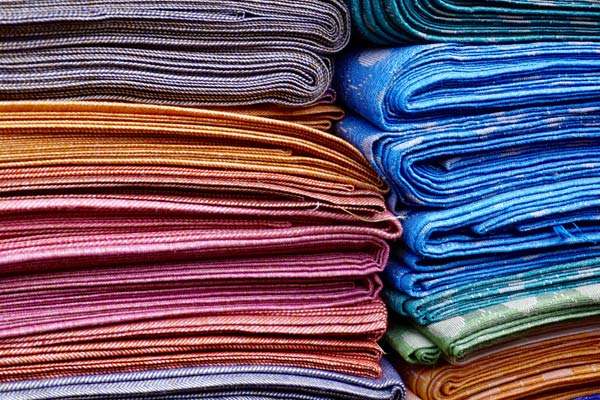Natural fabrics are as much a part of human history as fire, art, and agriculture. Here’s how some of the most common natural textiles are made, and how they’re used today.

As Steve Jobs once said, “Humans are toolmakers” — but he wasn’t just referring to Apple’s many iterations of the iPhone, which has become the technological tool of choice for millions of people across the globe. While the instruments we’ve used to build modern civilization have not always been so sophisticated, they’ve certainly been varied; and often, the most basic of materials have played an outsize role in the advancement of human society.
For example, plant-based textiles — which clothed us, sheltered us, and helped us carry supplies in ancient times — are just as significant today as they were thousands of years ago. While fabric technology has improved in the last century thanks to synthetic materials, the role of natural fabrics in fulfilling many of our most basic needs persists to this day.
Crafting to Survive: The History of Natural Fabrics
When we think about crafts, we may think about crocheting, paper mache, and maybe some colorful decorations on popsicle sticks. But by definition, crafting is any activity that involves skill in making things by hand — and for prehistoric man, it was key to survival. It gave our ancestors the ability to hunt more effectively with metal-tipped spears, or to preserve food in clay pottery. Only after humans mastered these skills did early humans begin to experiment with ornamentation.
The development of fabrics follows this same path. Early humans began building shelters from animal skins nearly 780,000 years ago, but the development of woven fabric is more recent. The oldest fabric fibers ever discovered, which were found in simple woven clothing made from flax, are nearly 36,000 years old. These fibers are a predecessor of linen, the oldest woven natural fabric.
By 5,500 BCE, the ancient Egyptians were regularly weaving and wearing linen clothing. Cotton fabric came slightly later, making its first appearance in Egypt and Mesoamerica by 3,000 BCE. Natural fabrics offered early humans significant advantages over furs: these clothes were lighter and easier to repair, and they shielded the wearer’s skin from the hot sun while keeping them relatively cool. This clothing was often decorative as well as functional, dyed bright colors with compounds from plants, minerals, and insects.
Modern Materials
Craftspeople around the world relied on natural fibers until the 1930s, when chemical company DuPont invented nylon, the first synthetic textile. Nylon quickly found a place in parachute cords and military ropes, but it became best known as a replacement for silk in women’s stockings. Spurred by nylon’s popularity, scientists began creating new synthetic fabrics that could resist water and stains, hold dye, and stretch to accommodate a variety of human body shapes.
Despite the success of synthetics, natural fabrics have never gone out of style. Textile manufacturers have had great success with natural-synthetic blends, which combine the lasting power of man-made materials with the breathability of natural fibers. But craftspeople still value pure cotton, jute, and linen fabric for a wide variety of uses. Below, we’ll discuss how these textiles are woven today, as well as how crafters can make use of them.
 Cotton
Cotton
Manufacturing Process
The manufacturing process for cotton has been significantly modernized since ancient Egyptian times. The cloth can be woven or knitted by machines, depending on the desired effect. Modern looms can process more than 2,000 meters of thread per minute while optical scanners identify any flaws in the fabric. In knitting machines, cones of cotton thread feed either a flat or conical machine, which uses roughly 2,500 needles to produce fabric at a rapid pace. An efficient knitting machine can sew over a million stitches every minute!
Uses
Pure cotton cloth is most widely used today as muslin. This thin, breathable, and inexpensive cloth has a number of applications, including within cheesemaking and fashion design. Amateur crafters use the cloth for bags, which are especially popular for holding party or wedding favors. The rustic style of these bags can tie any event together!
Crafters also value cotton twine for a number of decorative and practical purposes. Made by twisting two or three cotton yarns together, this durable cord can be dyed vivid colors and incorporated into DIY projects. Use it to wrap a lampshade, string lights together, or make friendship bracelets. Plain cotton twine can also be used to truss a chicken or tie a roast together in the kitchen.
Though many clothing manufacturers prefer synthetic blends, pure cotton fabric is still popular for jeans and other denim apparel. Thin t-shirts are also a popular use of cotton, since the material absorbs moisture and keeps the skin cool. However, owners of cotton clothing must be careful during washing, as it can shrink in hot water. Cotton canvas fabric is also commonly used in shoes and bags, since it’s washable and allows odors to easily escape.
 Jute
Jute
Manufacturing Process
The fiber of jute comes from the stem or outer skin of the plant. After retting, or separating the fibers in slow running water, workers strip the plant of its fibrous material. From this material, a number of different fabrics can be made, including hessian, burlap, and gunny cloth. Jute does not require pesticides to grow, and thrives in a tropical climate with heavy rainfall, which is why Bangladesh exports a significant amount of this crop.
Uses
Jute fibers are thicker and stronger than those of almost any other fabric material, which makes jute a great choice for sacks and bags that must carry a heavy load. Jute comes in several weaves: the looser weave makes the fabric lighter and less expensive to produce than linen or cotton, and these bags are commonly used to carry coffee beans and other crops. Crafters prefer a closer weave, which looks more polished for favor bags, runners, or other decorative purposes. Jute’s rough texture makes the fabric unfavorable for clothing, but jute floor mats are durable and a perfect complement to a rustic home.
 Linen
Linen
Manufacturing Process
Linen fiber must be obtained from the core of the flax plant, which is a labor-intensive crop to grow and notoriously difficult to work with. After multiple soakings and combings, the plant undergoes a process called scutching, in which workers extract the fibers from the woody parts of the stalk. The long and short strands of fiber are then separated and straightened to prepare for spinning. Once the fabric is spun, it’s woven on a mechanical loom.
Uses
Pure linen clothing is highly prized for its lightweight, breathable feel, and quick-drying properties. These attributes also translate well to bed and bath fabrics: linen’s absorbency makes it a good choice for bath and dish towels, while linen sheets keep sleepers cool throughout the night.
In a crafting capacity, linen enjoys wide popularity as a canvas for paintings — especially in Europe, where linen fabric is more common. Linen can also be used to make elegant bags for party favors; tie them with linen ribbon for a complimentary finishing touch! If your favors involve food, the breathability of linen fabric can keep baked goods fresh for your guests.
Even with the rise of synthetic materials, natural materials still play an important role in modern society. Craftspeople around the world rely on these fabrics to manufacture affordable, durable products, and many depend on this craft for their economic livelihood. We’re also beginning to see a resurgence in the popularity of natural fabrics, as more and more people favor these textiles for clothing and home and event decor. The lasting power of cotton, jute, and linen is indisputable — no matter how advanced our textile science becomes, natural fabrics will always play a primary role in our everyday lives.


This is a Great and informative article. I learn something new about natural fabric fibers
Great Post! you have define each and every thing in very detail and the content you
have used it is tremendous.